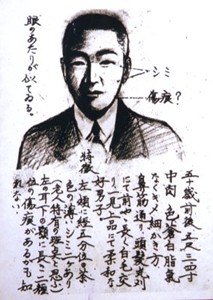 Since 1983, the average amount of time a condemned American convict spends on death row has tripled to 153 months. Yet that mammoth stretch of time is nothing compared to that endured by Sadamichi Hirasawa. When he passed away from natural causes in 1987, the alleged mastermind of Japan’s most infamous and lethal bank robbery had racked up 37 years waiting for the noose.
Since 1983, the average amount of time a condemned American convict spends on death row has tripled to 153 months. Yet that mammoth stretch of time is nothing compared to that endured by Sadamichi Hirasawa. When he passed away from natural causes in 1987, the alleged mastermind of Japan’s most infamous and lethal bank robbery had racked up 37 years waiting for the noose.
The eternal delay had much to do with the circumstances surrounding Hirasawa’s conviction. The facts of the crime were never in doubt: in 1948, a man conned a dozen bank employees into drinking cyanide, under the pretense that he was administering them a liquid vaccination for dysentery. But since the start, there have been credible rumors that Hirasawa was just a scapegoat, and that the real culprit was someone with close ties to Unit 731, the clandestine group that carried out horrific biowarfare experiments during World War II. This alternative theory goes something like this:
As the investigation progressed, the evidence began to implicate a former member of Unit 731 of the Imperial Army—the unit which, under the command of Lt. Gen. Shiro Ishii, conducted biological warfare research in Manchuria by means of grisly experimentation on captured prisoners. The poison in teh bank robbery was administered, it was learned, by a method used regularly in Manchuria. One survivor was certain the murderer was a doctor. General Ishii himself was called in to “consult” on the case.
Suddenly, however, this line of investigation was terminated, apparently at the behest of someone high in MacArthur’s command. With the Japanese public clamoring for action, the police turned their attention again to Hirasawa, who was convicted and sentenced to death.
MacArthur supposedly had a keen interest in granting amnesty to Unit 731’s members, so that their expertise could be tapped in the service of America’s burgeoning bioweapons program. To this day, that is a narrative that Hirasawa’s descendants continue to try and bring to light.
Plenty of primary-source documents can be found here, though many require a working knowledge of Japanese to decipher fully. And one of Hirasawa’s self-portraits from death row can be glimpsed here.


Jordan // Nov 13, 2009 at 2:49 pm
Given things like Operation Paperclip, it wouldn’t be surprising if the US had wanted to spirit away some more foreign brains. However, Unit 731 was one of the more excrable examples of human ingenuity during WWII and I sincerely hope that we passed that particular opportunity up. Diseases as weapons are one of the dumber ideas man has come up with in the long history if finding new and exciting ways to slaughter each other.
Brendan I. Koerner // Nov 13, 2009 at 3:15 pm
While it’s clear that we purposely declined to opportunity to prosecute members of Unit 731, debate remains over what role these war criminals were given in the development of America’s bioweapons program. I’ve come across claims that Ishii himself was brought to Fort Detrick in the early 1950s, to lecture about his specialty. But Ishii’s family has long denied this, and I’ve yet to see ironclad evidence of his presence on American soil.
It is clear, though, that Ishii was permitted to live out his days peacefully, having faced no repercussions for his monstrous actions. And that fact is certainly to the discredit of the Allies.